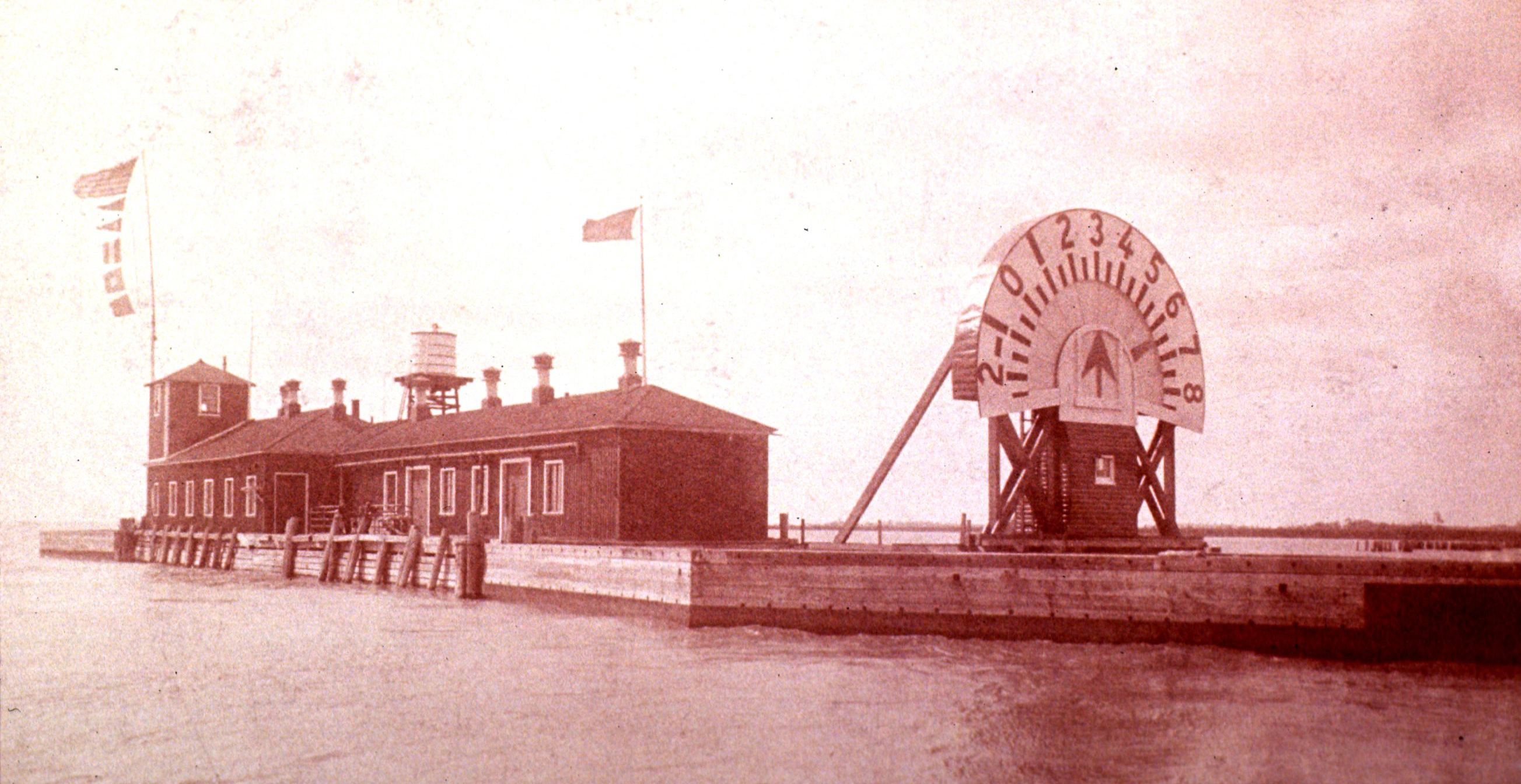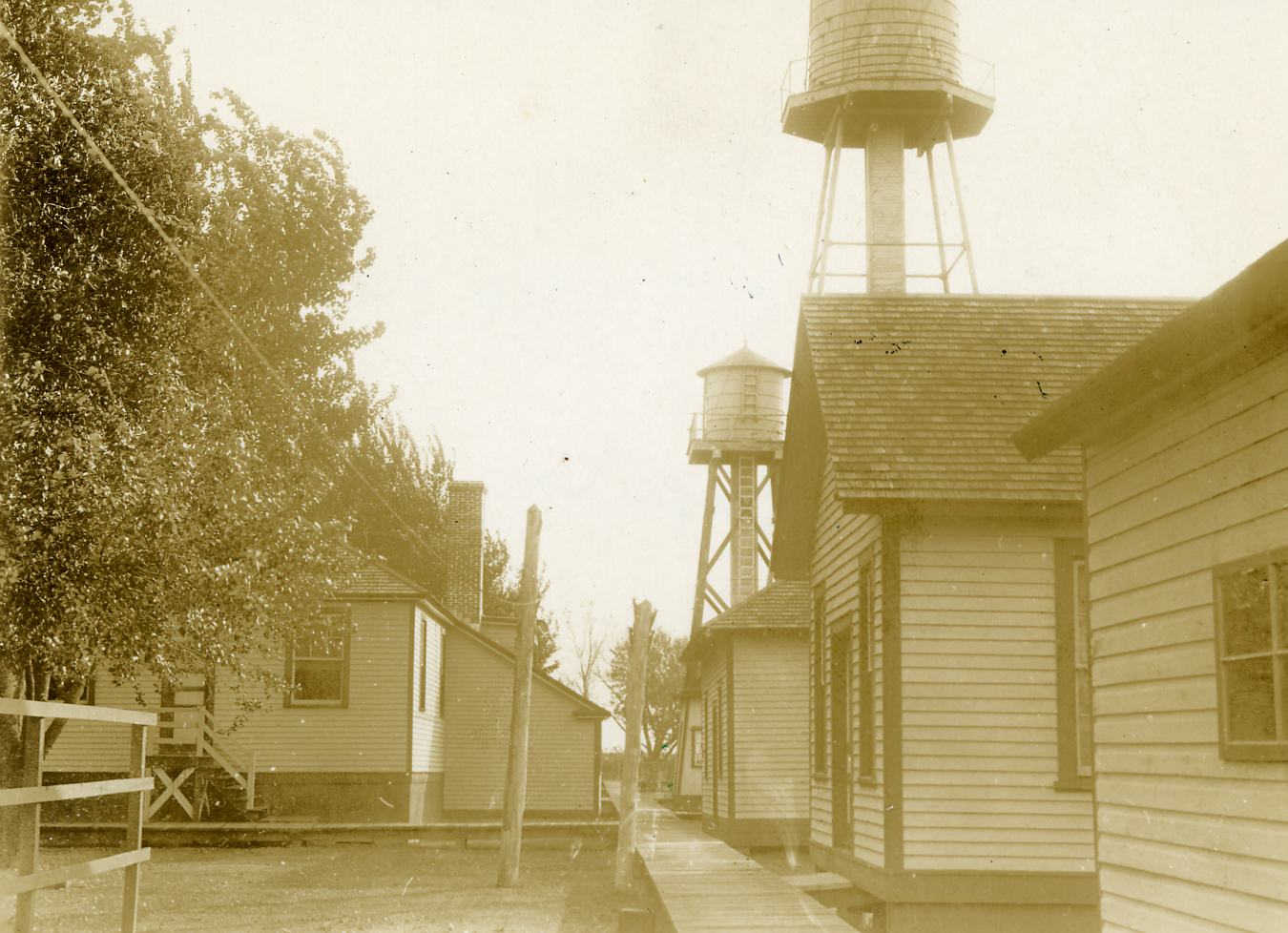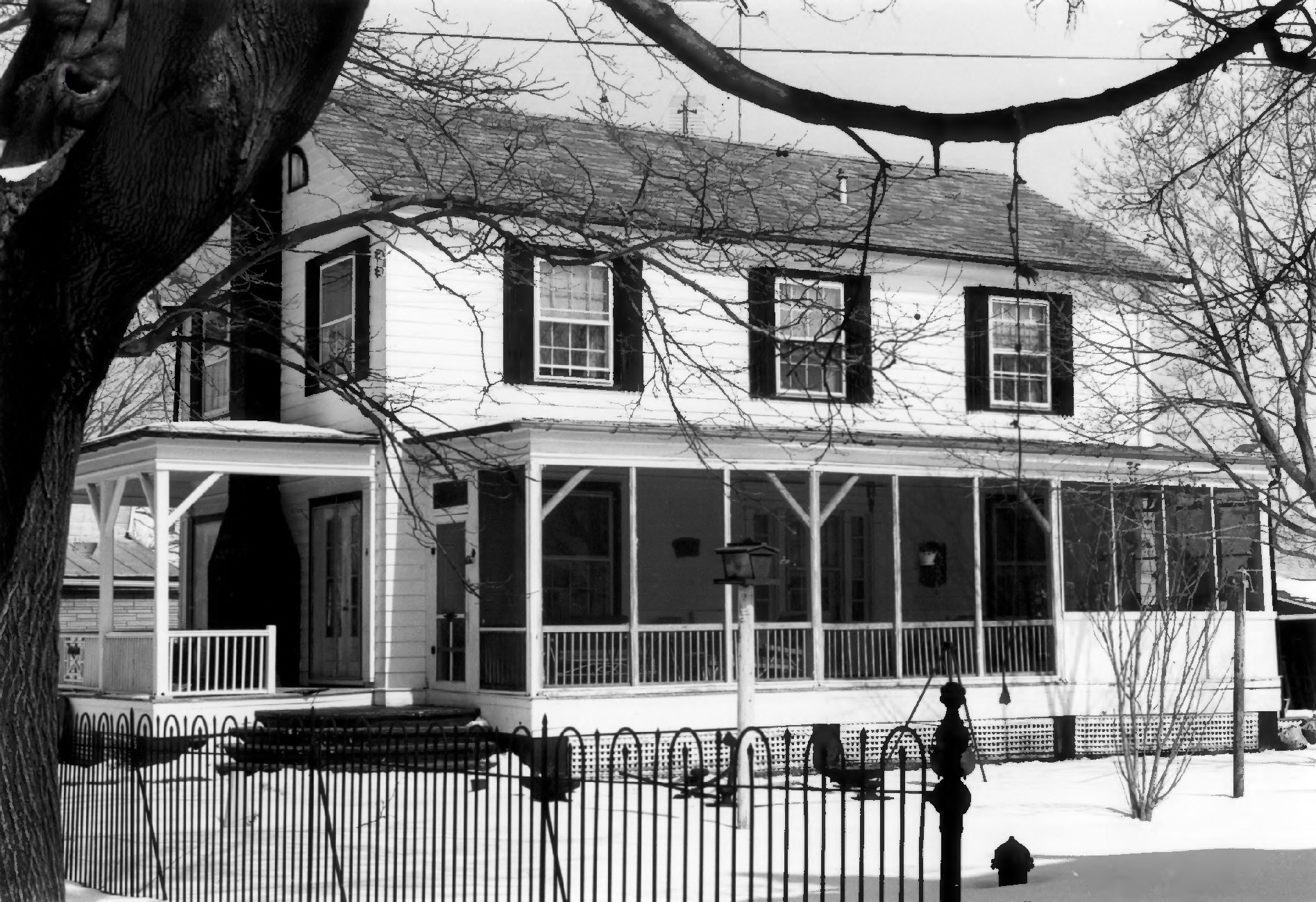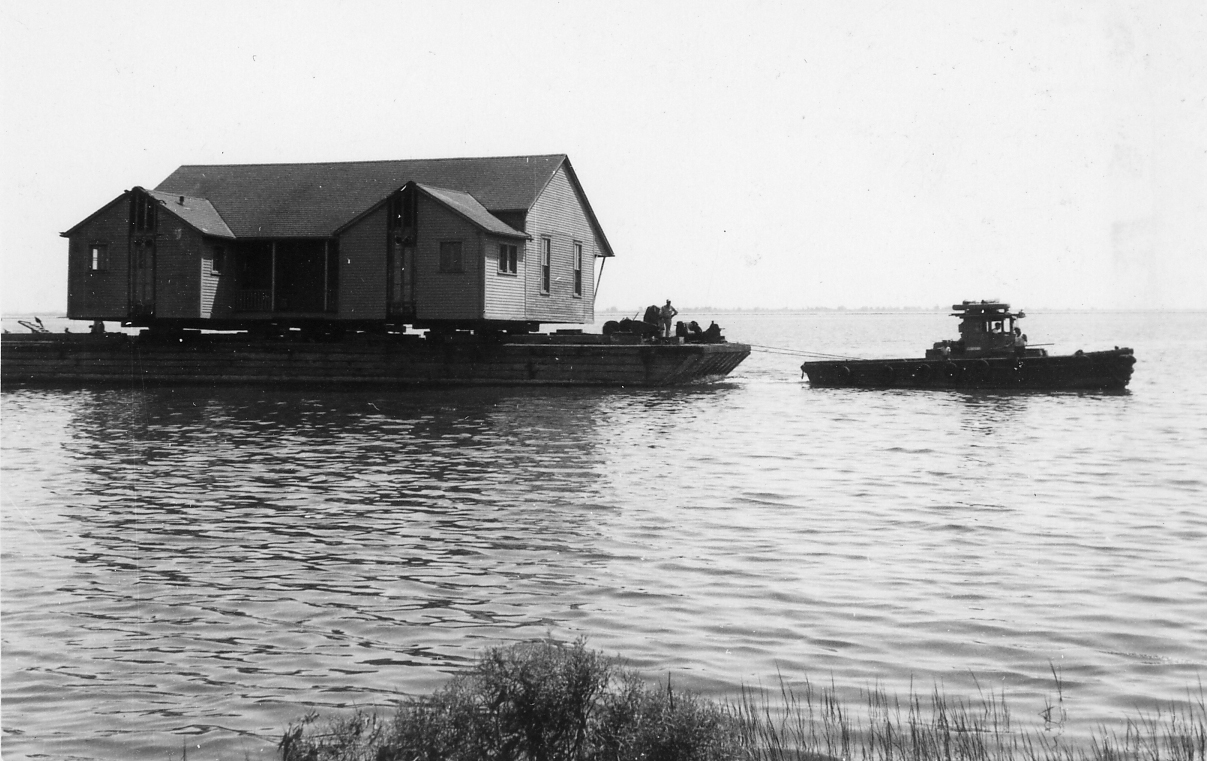
Reedy Island and Port Penn
Reedy Island
The next time you’re crossing the Reedy Point Bridge, or walking the old Port Penn wharves at the end of Market Street, look out into the river and you will see the 50 or so acres of Reedy Island. Deserted now, at one time it was on the front line of the public health system.
The story of Reedy Island starts at the end of the 19th century. It was a time of increased immigration to the US, and growing cities, and people living close together, and epidemics. Modern medicine’s arsenal of antibiotics and vaccines were not available then, but doctors did know of the relation between germs and disease, they knew about contagion, and they knew the value of quarantine and disinfection.
The first quarantine station on the Delaware was built in 1798 in Essington, south of Philadelphia, and operated by the state of Pennsylvania. Quarantine inspection comprised examination of the crew and passengers, water supply, toilets, and “general sanitary condition” of the ship. Any vessel infected with cholera, yellow fever, tuberculosis, plague or small pox would be disinfected. [1] Steam was used to sterilize clothing, sulfur dioxide gas was piped into ships, and if anyone was sick, everyone was quarantined until they were no longer contagious.
The US government established its own quarantine station at Cape Henlopen in 1884. This station handled thousands of immigrants headed to Philadelphia from Europe and Cuba. [2]. While at first only ships from infected ports were inspected, in 1892 an outbreak of cholera was feared and all ships were required to stop at the inspection port. US government officials realized another inspection site was needed, closer to Philadelphia, and Reedy Island, already owned by the US government and site of a lighthouse [3], was chosen.
Money from the federal epidemic fund was allocated in March, 1893; construction began at once, and the station was opened on July 1, 1893. A large pier, 200 feet by 40 feet, extended out into the channel from the east side of the island. The depth at low tide was 30 feet which allowed ships to tie up directly to the pier during disinfection. A large shed on the pier housed the disinfecting equipment: a boiler for generating steam, two steam chambers for disinfecting clothing, a sulfur generator and hoses for carrying the sulfur dioxide fumes to the ships, and several large water tanks (Fig. 1). An observatory was built at the end of the pier, and connected to the mainland via a telegraph cable running through Port Penn.

Figure 1 Disinfecting Pier on Reedy Island with the tide indicator in front. [4]
Buildings on the island itself comprised a cottage hospital, attendants’ quarters, and surgeon’s quarters. All the buildings were constructed on pilings to be above high water, and connected by gangways (Fig 2). The total cost of the quarantine station was about $67,000 ($1.7 million in 2014 dollars).

Figure 2 Reedy Island buildings [5].
Even after their passengers were quarantined at Cape Henlopen, all the ships coming up the Delaware were obliged to stop at Reedy Island. On July 7, 1901, for example, T. F. Richardson, Assistant Surgeon, reported the arrival and inspection of 5 vessels carrying fruit, molasses and ore, from Cuba and the West Indies [6].
The installation was improved several times over the years, with $150,000 being spent in 1919 alone for additional buildings and quarters [7].
By the end of World War II the quarantine station was closed and the US government wanted to sell the island and facilities. John Mitchell was appointed caretaker of the island in 1948 and lived there with his wife, two children, and his dog. In 1949 Shelby Collins of Port Penn offered the government $7,500 for the buildings, equipment, and coal in the bins.
Collins was then 78 years old, and had helped build the original installation in 1893 [8]. The government turned his offer down as being too low. Collins got his way eventually, as after the quarantine station was decommissioned in 1955 he moved several houses to Port Penn on barges.
Port Penn
In 1978 the Port Penn was nominated for and received recognition from the National Park Service as an Historic District. Part of the nominating process involved an extensive study of all the houses in Port Penn. [9] In 1996 a team led by Bernie Herman also studied the houses [10]. Between these two studies we have a detailed description of most of the houses in Port Penn.
According to Herman, “Port Penn's landscape was improved with a third phase of house construction. Most notable among the new houses are the buildings moved by Shelby Collins from Reedy Island into the village after the federal installation on that island was decommissioned in 1955. Chief among these buildings are the Commodore's House on the northern extension of Congress Street and two pyramidal-roofed dwellings on south Congress Street below Merchant.” [11]
The Commodore’s House was moved to 4 North Congress St. “While on the island, it served as the primary residence for the commanding medical officer running the quarantine station located there. Another bungalow built around 1930, this central-hall plan house features two front rooms for entertaining guests, another aspect of the government official's responsibilities.” [12] In Port Penn the house was positioned so that the original front porch is turned to the side, facing the Cleaver House. “Built in the colonial revival style, the Commodore's House is a two-story, three-bay, center-hall-plan dwelling of weather-boarded frame construction with a gable roof. The interior retains much of its original trim including colonial revival mantels, doors and woodwork.” [13]

Figure 3 Commodore's House from Reedy Island in 1978. This is the original front entrance which now faces the Cleaver House. [14].
Two other houses in Port Penn proper also were brought from Reedy Island. “Situated side-by-side, both houses are squared, double-pile structures [2-rooms deep] capped with pyramidal roofs sheathed with raised seam tooled sheet metal and terminated by small-windowed monitors at the peak. Both houses also have flat, flared, hip roof porches and rear one-story lean-to additions.” [15]
The first, at 111 South Congress St, is known as the Reedy Island Barracks House (Fig. 4). It is a “two-story, five bay [5 window] frame house [that] probably served as a barracks type resident for single employees on Reedy Island. The central door is located beneath the broad hipped porch roof supported by two squared wooden posts.” [16] This house looks much as it did when surveyed in 1978 except that the metal roof has been replaced with shingles.

Figure 4 The Reedy Island Barracks House, located at 111 S. Congress St in 1978. [17]
The second house is right next door at 113 South Congress Street (Fig. 4). Known as the Reedy Island Officer’s House, here “we see a more modest scale than the Commodore's, suitable for lower level government officials. The hipped roof with a glazed monitor on top is a common feature used to survey approaching ships from a protected space. Here, small paired windows are hung directly beneath the wide eaves and the white weatherboard is laid in a vertical pattern with a saw-tooth pattern at the bottom of the slats.” [18]
Figure 5 The Reedy Island Officer's House, located at 113 S. Congress St in 2014. [19]
The last house known to have been moved from Reedy Island is shown in Figure 6. This house is currently located at Augustine Beach, south of the Augustine Inn and has recently been remodeled (Fig. 7).

Figure 6 A house being moved from Reedy Island in 1955. The chimneys have been removed from the two extensions at the rear of the house. [20]

Figure 7 The Reedy Island house today at Augustine Beach. The chimneys have been rebuilt at the rear of the two extensions. [21]
Notes
1. Taylor, Frank H., The Handbook of the Lower Delaware River (1895), (last accessed 06/20/2019). [back]
2. Delaware Online Dec 3 2014 (last accessed 02/14/2015). [back]
3. Old Reedy Island Lighthouse (last accessed 06/20/2019). [back]
4. Images from the History of Medicine (1893) (last accessed 02/14/2015) [back]
5. Photo courtesy Port Penn Area Historical Society. [back]
6. Arrival at Reedy Island Quarantine Station of vessels from West Indian and Cuban ports (last accessed 06/20/2019) [back]
7. The Sunday Morning Star (Wilmington, DE) Aug 10 1919 (last accessed 06/20/2019) [back]
8. The Evening Independent (St Petersburg, FL) Sep 5 1949 (last accessed 06/20/2019) [back]
9. Herman, Bernard, et, al., National Register of Historic Places Inventory-Nomination Form (Document 1 and Document 2 ) (1977) (last accessed 02/14/2015). [back]
10. Warner, Pamela, et. al., The Architectural Resources of Port Penn (1996) (last accessed 06/20/2019) [back]
11. Warner (1996), op. cit. [back]
12. Warner (1996), op. cit. [back]
13. Herman (1977), op. cit. [back]
14. Herman (1977), op. cit. [back]
15. Herman (1977), op. cit. [back]
16. Warner (1996), op. cit. [back]
17. Herman (1977), op. cit. [back]
18. Warner (1996), op. cit. [back]
19. Photo courtesy of Wes Jones. [back]
20. Photo courtesy Port Penn Area Historical Society. [back]
21. Photo courtesy of Wes Jones. [back]
| www.portpenn.org
©2019 Port Penn Area Historical Society | web design by Jones & Beck | v. 06/20/19